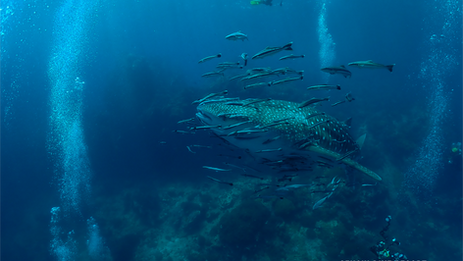Koh Ngam Yai
Best Times: February - October
Koh Ngam Yai is the larger of two island formations located just 17 kilometres off the coast of Chumphon. The underwater landscape consists of limestone with sparse vegetation amidst the natural, almost artistic, rock structures. Truly one of the best Chumphon dive sites, Koh Ngam Yai is popular with both SCUBA divers and snorkellers and is considered one of the most famous spots in the Gulf of Thailand for both activities. The colourful corals are home to many fish species, and the mild currents and exceptional visibility make it a firm favourite for Sensui Dive Resort customers.
Hin Chedi
Best Times: February - October
This dive site off the southernmost tip of Ko Ngam Yai is named after the magnificent rock pinnacles which protrude from the surface there. Originating from Sanskrit, a Chedi is a mound-like or hemispherical structure made popular by Buddhist architecture. The natural formation of these bulbous rocks gives this Chumphon dive site its name. Underwater, the terrain is characterised by loose boulder formations, healthy corals, and abundant anemone fields. Brightly coloured tropical fish and passing turtles provide plenty for divers to see.
Hin Pae
Best Times: February - October
Hin Pae is located north of Koh Ngam Yai and is a unique dive site formed by an assembly of rocks that barely protrude the surface. The main point of interest is provided by the wreck of a Thai shipping vessel that sunk in a storm a few years ago. Since sinking, the ship has been slowly disassembling, with various parts finding new homes scattered across the reef. The maximum depth is 24m, but 10-15m is usually the optimum depth. Hin Pae is abundant in sea anemones, black corals, sea whips, giant clams, butterflyfish, barracuda, stingrays, turtles, and even whale sharks are spotted occasionally.
Koh Ngam Noi
Best Times: February - October
Koh Ngam Noi lies 400 meters south of Koh Ngam Yai. It is only a third of the size of its sister island but very alike in its beauty. The best diving spot is at the southern tip, where there is a naturally formed swim-trough. Most divers stay close to the rocks as this is one of the best Chumphon dive sites to search for different types of nudibranch. Schools of fish include snappers, jackfish, and yellowtail barracuda, and blue-spotted stingrays can often be spotted on the sand.
HTMS Prab 741 Wreck
Best Times: February - October
The vessel was commissioned in 1944 and was originally designed by the US Navy for Pacific island-hopping campaigns in World War II. In time, it was handed to the Thai Navy and used as a training vessel before being decommissioned. The ship was donated to Chumphon Province in 2011 for use as an artificial reef, and is now considered one of Chumphon’s best dive sites. The HTMS Prab lies at a shallow depth giving PADI Open Water divers easy access. A variety of marine life can be spotted, including large schools of one-spot snapper, fusiliers, and even the occasional hawksbill turtle or whale shark.
Hin Lak Ngam
Best Times: February - October
Koh Hin Ngam is a small island of polished black volcanic rock formed by the ebb and flow of waves hitting its walls for thousands of years. It is located 2.5km south of Koh Ngam Noi and comprises two rocky outcrops. The maximum depth is 20m, visibility is usually good, and currents are mild. This dive site is well known for its healthy corals, including staghorn, table, brain, cabbage, and black varieties. Barrel sponges and anemone beds surround the island, and resident fish species include triggerfish, pufferfish, porcupinefish, and Moorish idols.
Sam Laem
Best Times: February - October
This dive site gets its name from the three large rock pillars which have formed underwater in the shape of a triangle. Sam Laem, meaning ‘triangle’ in Thai, has a maximum depth of around 30 metres, and visibility is typically around 20 metres. This makes it an excellent option for fun divers who want to explore a little deeper, or students on PADI Advanced Open Water courses or Deep Specialty dives on the PADI Master Scuba Diver course.


























